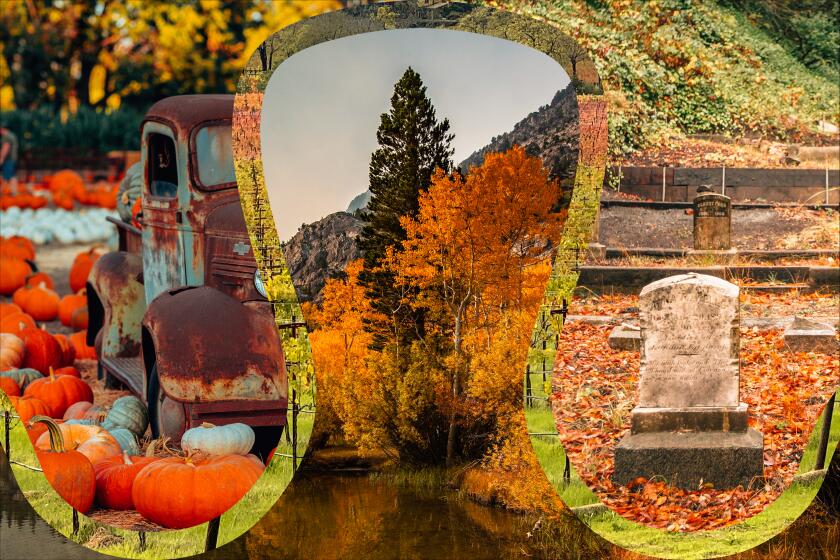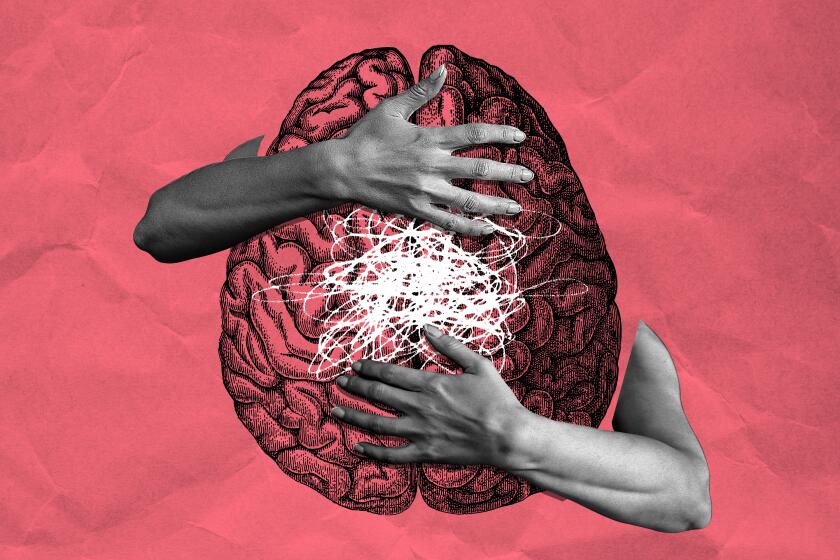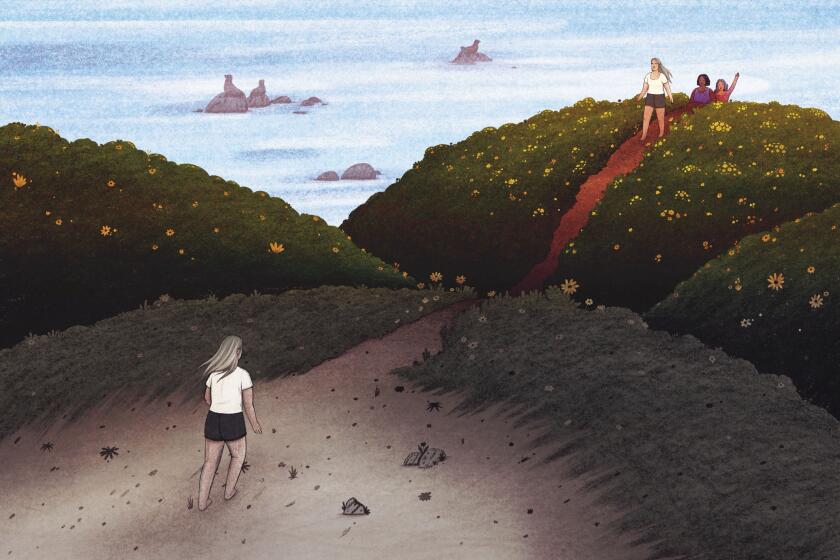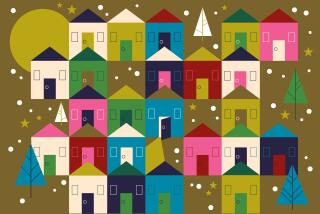How do you welcome the fall season in sunny L.A.? I went on a personal quest to find out
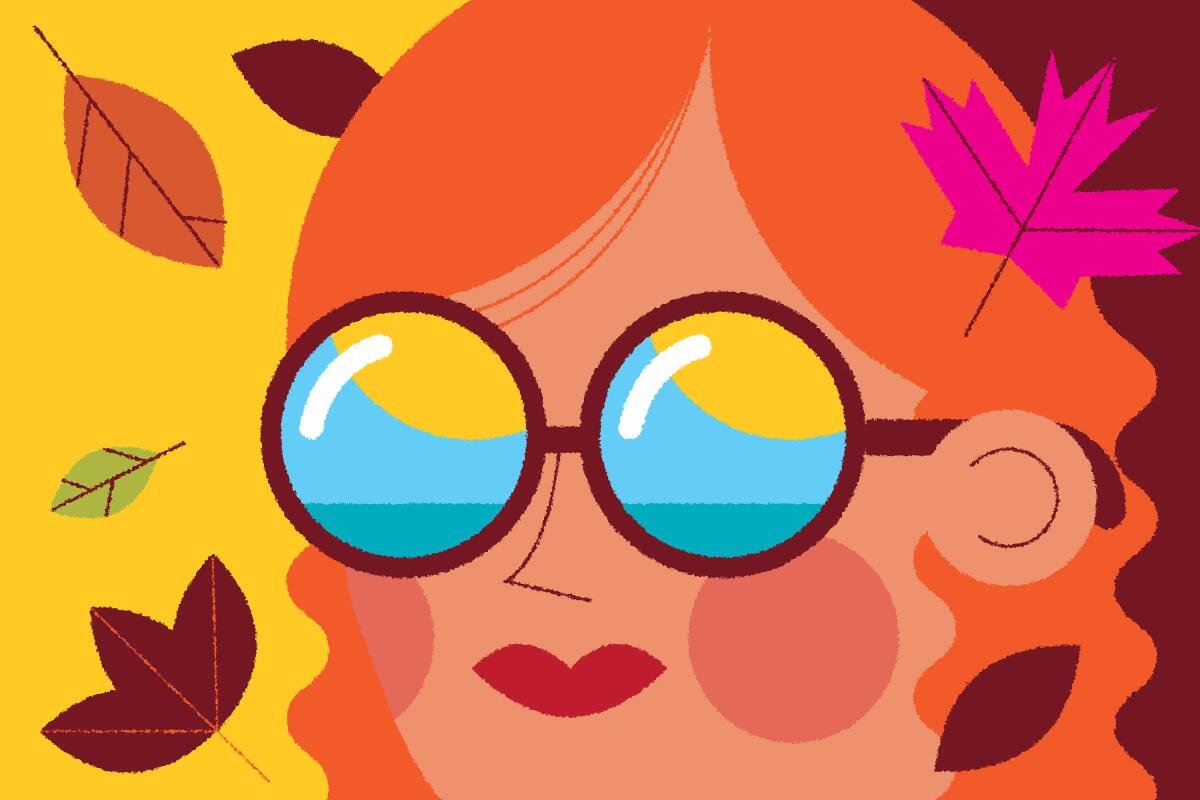
- Share via
- L.A. is notorious for its warm falls, making it hard to transition between seasons.
- The author sought worthwhile fall rituals to ease the anxiety she feels during this time each year.
During this year’s early September heat wave, I sat in a shaded courtyard at USC struggling to write after teaching my classes. The oppressive noon heat stifled my brain while sweat streamed from my temples. After a few minutes of internal debating — it’s after Labor Day, it’s time to work — I fled to my car. When I got home, I flung myself onto the couch, basking in the AC’s icy coolness as if it were manna from heaven.
Most of the country frolics into fall with hot spiced drinks and cute chunky sweaters, but in L.A., we’re forced to cosplay the season. We search for symbols that a shift is underway while summer often extends into November. And it’s exactly that dissonance between the autumn season and our Southern Californian climate that recently propelled me to search for more meaningful ways to honor fall — 98 degree days be damned.
Fall is here. Try these road trips around California with destinations for picking pumpkins, peeping leaves, seeing spooky sights and more.
The fall has always made me nervous and fearful, especially because it’s been a historically traumatic season for me. Fifteen years ago, I had a late-stage miscarriage for reasons that remain unknown. A few years later, a driver crossed over the road’s dividing line at 70 miles per hour and crashed head-long into my family’s Volvo. We spun around five times, my two toddlers buckled into their car seats. When the airbag shrouded my face in a soft white cloud, I momentarily thought I had died. Four years later, my then 7-year old daughter and her friend fell through a plexiglass skylight window at a rooftop party. The seconds it took to run down those stairs and find her on the hardwood floor, not knowing if she was alive, will forever haunt my husband and me. Miraculously, she walked away with just a few scratches.
Along with stirring up these painful memories, the fall also signals the end of summer’s languor. Summer is a streak of extroversion and adventure full of unhurried afternoons and al fresco dining. Kids stay up late, ice cream becomes a food group and people are out and about, undergirded by an unspoken permission to meander through the days. Fall is when the light fades as we turn back the clocks and tunnel toward the winter dark. Many of us carry the imprint of “back to school” worries, our proverbial backpacks heavy with what the season will yield. We strive to achieve as intensified workloads and familial and holiday obligations begin to chip away at our free time.
The fall is also a precursor to darkness. And a seasonal reminder of humanity’s ultimate truth: Time is finite and we’re all hurtling toward our own mortality.
Not to say I don’t have a few good decades left! So I figured I might as well spend them with worthwhile fall rituals. So I looked to history as a guide. In doing so, I realized the ancients also needed rites and rituals to ease them into the gathering darkness. For them, fall meant celebrating both abundance but also a deep collective fear that the harvest wouldn’t last, their provisions scarce come winter.
The ancient Eleusinian mystery rites practiced for thousands of years throughout the Mediterranean world began in the earlier half of the year for preparation of the latter half. It culminated in a ritual bath in the sea, three days of fasting and a pilgrimage to the Sanctuary of Eleusis outside of Athens during a nine-day festival in early fall.
Although much of what occurred at the sanctuary is shrouded in mystery (hence the name), scholars of ancient Greco-Roman religion suggest that the participants reenacted the myth of Demeter and Persephone to illustrate how Hades abducted Persephone into the underworld. Her descent into darkness symbolized the harbinger of fall, when crops gradually withered. She would emerge again in the spring and summer months as a symbol of fertility and rebirth.
From abandoned zoos to haunted forest hikes, these spots will terrify you 365 days a year
The ancients practiced these rites to experience the cyclical nature of life. Acknowledging that darkness and death were inevitable, they also held the hope, through these communal rituals, that the light would return, the grain would grow again and life would ultimately prevail over death. They understood that psychologically, to experience a rebirth, you must first die.
I might not have time to pencil in a nine-day festival and trip to Athens, but I realized I could be more intentional about honoring this new season’s darkness, instead of wishing it all away.
I first switched to a so-called “fall diet.” No, that does not include pumpkin spice lattes. It’s an ayurvedic practice meant to reflect “vata season,” characterized by the ancient medicinal practice originating in India, as dry, cool and windy.
“You should eat foods that hug you,” advised Kim Harrington, a Pacific Palisades-based yoga teacher and practitioner in ayurvedic medicine. “The food should be warm, soft and loving to combat vata’s dry coolness,” she said. “Vata season is about slowing down and grounding ourselves so that we are not depleted once summer rolls around again.”
I opted for stews and soups infused with spices such as ginger, turmeric and cinnamon, particularly Harrington’s red lentil dal recipe. Consuming it warmed me from the inside out. Not only that, I took time to enjoy the food I had prepared, even amid the fall semester chaos.
“Vata season is about slowing down and grounding ourselves so that we are not depleted once summer rolls around again.”
— Kim Harrington, Pacific Palisades-based practitioner in ayurvedic medicine
To complement my new fall diet, Harrington also suggested abhyanga, a routine that involves giving yourself a massage using a carrier oil (such as sesame) combined with essential oils like sweet orange or lavender. The point of the ritual, in part, is to “help us feel more love from ourselves and more connected to our emotions,” Harrington explained.
That night, I tried it, working my joints in a circular motion and the limbs in long strokes. At first, I felt embarrassed. Here I was sitting on my yoga mat massaging myself with lavender oil. Was this self-indulgent? But as the minutes passed, I gave into the sensation and let myself relax.
Since then, the practice has become my before-bed routine; I do it for five minutes, or sometimes for 14; it doesn’t really matter. What does is the sensory experience of grounding myself in the present moment and tuning into my body. On top of improving my sleep, it has reduced that static low-level anxiety that always plagues me in the fall.
Though the ayurvedic approach to fall was calming, it was also solitary. I found myself yearning for something more communal. So as my final effort in making peace with the fall, I decided to reconnect with Judaism, the religion of my roots.
I realized that I didn’t know much about how the religion honors the fall aside from Rosh Hashana, a veneration of the harvest marking the Jewish new year, followed by the High Holy days. This 10-day stretch ends with Yom Kippur, a day of fasting, repentance and commemoration of the dead. In the past, I had only experienced these holidays on a surface level, enjoying the delicious brisket and challah, and wishing everyone “shana tova” as I dipped apple slices in honey and popped them into my mouth. The honey always felt like a talisman of sorts, hoping its sweetness would last, and not become eclipsed by sorrow.
Researchers at UC Berkeley say a daily 20-second ‘micropractice’ can help reduce stress and improve mental health.
Earlier this month, I attended services with my best friend to celebrate the Jewish new year for the first time in decades. We were running late to morning services, held at Founder’s Church in Koreatown, but then I saw a stream of people trickling into the entrance: families with kids, same-sex couples, lots with tattoos and piercings, elderly people and tired-looking teenagers.
My usual anxiety about punctuality dissipated. The host of the services, Nefesh, maintains a fluid “come as you are” attitude, unlike the stuffy atmosphere of my youth temple. They focus on accessing the wisdom of our ancestors within a welcoming community to help one navigate these uncertain times — exactly what I had been searching for.
At the front gate, when I said my last name, the woman who greeted us warmly replied, “Oh, we have lots of Landaus in our family.” We then picked up our name placards. I realized that the woman handing them to me dances at the same ballet studio as I do. “Here we are, two Jewish ballerinas,” she said.
Inside the packed venue, the soaring music and prayers enveloped me. Rabbi Susan Goldberg spoke with infectious joy about hachniah, which means surrendering to the greater oneness of our communities in the world and the cosmos. She instructed us to breathe in what we needed in the new year and breathe out what we didn’t. As I followed suit, tears unexpectedly sprung into my eyes.
After two hours, my husband and son left for home, but I stayed. Soon, I felt a tap on my shoulder. The elderly couple sitting behind me whispered, “We are sorry your family left. We already miss them!” “Thank you so much,” I whispered back, touched by their act of noticing.
Toward the end of the four-hour service, Goldberg called anyone up to the stage who was holding onto fear. Over half the congregation, including myself, clambered up. She told us to dance with our fear instead of trying to overcome or battle it.
When I reached midlife, I was struggling with depression and a changing body. Then I went on a quest to connect with my community — and myself.
“But when you’re done dancing with it, the fear can sit back down,” she said.
When the blast of the shofar ushered in the new year, I thought about the soul-searching happening inside everyone around me. We felt both grief and hope reflected in this seasonal shift. By gathering together to honor those emotions, I was reminded that I don’t have to brave it alone when darkness descends.
Nearly a month into fall, I feel a little less fearful of the season. I now have a “fall toolbox” to source from. Whether that means making a big pot of red lentil dal to sustain me throughout my overscheduled weeks or joining family and friends to commune in grief and regret while also holding space for hope. It might not be as sweet a fix as pumpkin spice, but it’s one that will sustain me to the summer.
More to Read
Sign up for The Wild
We’ll help you find the best places to hike, bike and run, as well as the perfect silent spots for meditation and yoga.
You may occasionally receive promotional content from the Los Angeles Times.
